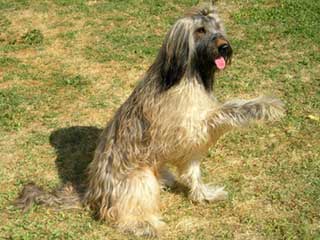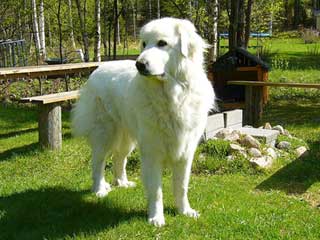| Grooming: |  |  |  |  |  |  |
| Shedding: |  |  |  |  |  |  |
| Energy Level: |  |  |  |  |  |  |
| Protection: |  |  |  |  |  |  |
| Watch Dog: |  |  |  |  |  |  |
| Group: | Herding |
| Size: | Large |
| Life Span: | 10-12 years |
| Height: | Male: 23-27 inches |
| Female: 22-26 inches | |
| Weight: | Male: 70-75 lbs |
| Female: 65-70 lbs |
Briard Facts
| Coat : | Outer coat is flat, dense and hard. Undercoat is short and tight |
| Gait : | Agile and light |
| Color(s) : | Any color except white (usually black, gray or tawny) |
| Living Area : | Average |
| Hair Length: | Long |
| Exercise Need : | Daily long walk and jog |
| Recognized By : |
(CKC) Canadian Kennel Club (FCI) F�d�ration Cynologique Internationale (AKC) American Kennel Club (UKC) United Kennel Club (KCGB) Kennel Club of Great Britain (CKC) Canadian Kennel Club (ANKC) Australian National Kennel Council (NKC) National Kennel Club (NZKC) New Zealand Kennel Club (APRI) America Pet Registry, Inc. (ACR) American Canine Registry (DRA) Dog Registry of America |
| Date of Origin : | Ancient |
| Place of Origin : | France |
| Todays Use : | Companion Dog |
| Originally Used : | Herding |
| Other Name : | Berger De Brie, Berger Briard |
Briard Information
Briard Description:The exact origin of the Briard is unknown. The popularity of this breed grew in the later part of the 19th century after the Paris dog show. This breed was first recognized by a man named Pierre Megnin and was differentiated from the Beauceron. The breed played an important role in the French Revolution, working as a messenger and for detecting mines. It was also used as a flock herder and guardian. The breed was first recognized by the AKC in 1928. |
Briard Care & Grooming:The Briard is an average shedder. Its long and dense coat needs extensive grooming. The coat needs to be brushed 3-4 times a week and should be rubbed occasionally with a damp towel. The coat should also be trimmed regularly to prevent matting of the hair. It should be bathed only when necessary and must be dried properly after each bath. Its eyes and ears need to be cleaned regularly to avoid any infection. Its nail and, the hair around ears, eyes and paws should be trimmed regularly. |
Briard Health Problems:The Briard is prone to some health issues like Cataract, Ear infection, Bloat, hip Dysplasia etc. |
| Group: | Sporting |
| Size: | Large |
| Life Span: | 10-12 years |
| Height: | Male: 22-24 inches Female: 21-23 inches |
| Weight: | Male:55-68 lbs Female: 45-58 lbs |
| Color: | Various shades of liver |
| Description: | The exact origin of the Irish Water Spaniel is relatively unknown. The father of this..... |












